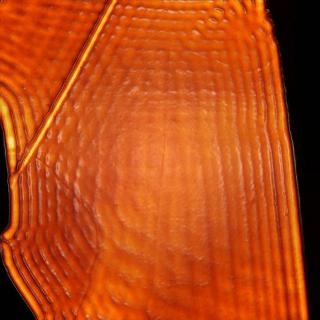Jan 8 2018
A team of physicists, guided by the U.S. Naval Research Laboratory (NRL), have shown the means to enhance the optical loss features and transmission efficiency of hexagonal boron nitride devices, enabling tiny lasers and nanoscale optics.
 Image shows directly measured polaritons propagating through a flake of Hexagonal boron nitride (hBN). (Photo credit: U.S. Naval Research Laboratory)
Image shows directly measured polaritons propagating through a flake of Hexagonal boron nitride (hBN). (Photo credit: U.S. Naval Research Laboratory)
“The applications for this research are considerably broad,” said Dr. Alexander J. Giles, research physicist, NRL Electronics Science and Technology Division. “By confining light to very small dimensions, nanophotonic devices have direct applications for use in ultra-high resolution microscopes, solar energy harvesting, optical computing and targeted medical therapies.”
Hexagonal boron nitride (hBN) forms an atomically thin lattice made up of nitrogen and boron atoms. This material has lately been exhibited as an exciting optical material for infrared nanophotonics and is said to be an ‘ideal substrate’ for 2D materials.
While earlier research showed that natural hBN supports deeply sub-diffractional hyperbolic phonon polaritons preferred for applications such as sub-diffractional optical imaging (so-called ‘hyperlensing’), chemical sensing, energy conversion and quantum nanophotonics, limited transmission efficiencies continue to persist.
"We have demonstrated that the inherent efficiency limitations of nanophotonics can be overcome through the careful engineering of isotopes in polar semiconductors and dielectric materials,” Giles said.
Naturally occurring boron contains two isotopes, boron-10 and boron-11, lending a 10% variance in atomic masses. This variance results in considerable losses because of phonon scattering, restricting the potential applications of this material. The research team at NRL has developed greater than 99% isotopically pure samples of hBN, meaning they consist almost totally of either boron-10 or boron-11 isotopes.
This method results in a significant reduction in optical losses, creating in optical modes that travel up to three times farther and persist for up to three times longer than natural hBN. These long-lived vibrational modes not only enable instant advances specific to hBN — near field optics and chemical sensing — but also provide a strategic methodology for other materials systems to utilize and build upon.
Controlling and manipulating light at nanoscale, sub-diffractional dimensions is notoriously difficult and inefficient. Our work represents a new path forward for the next generation of materials and devices.
Dr. Alexander J. Giles, Research Physicist
Contributors to this study include researchers from the University of California San Diego, Kansas State University, Oak Ridge National Laboratory, Columbia University, and Vanderbilt University. Complete details of this study entitled “Ultralow-loss polaritons in isotopically pure boron nitride,” can be found in the December 11, 2017 issue of Nature Materials (doi:10.1038/nmat5047).